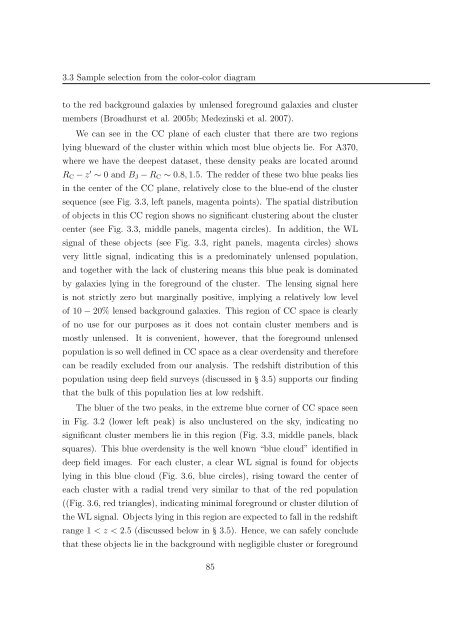Mass and Light distributions in Clusters of Galaxies - Henry A ...
Mass and Light distributions in Clusters of Galaxies - Henry A ...
Mass and Light distributions in Clusters of Galaxies - Henry A ...
Create successful ePaper yourself
Turn your PDF publications into a flip-book with our unique Google optimized e-Paper software.
3.3 Sample selection from the color-color diagram<br />
to the red background galaxies by unlensed foreground galaxies <strong>and</strong> cluster<br />
members (Broadhurst et al. 2005b; Medez<strong>in</strong>ski et al. 2007).<br />
We can see <strong>in</strong> the CC plane <strong>of</strong> each cluster that there are two regions<br />
ly<strong>in</strong>g blueward <strong>of</strong> the cluster with<strong>in</strong> which most blue objects lie. For A370,<br />
where we have the deepest dataset, these density peaks are located around<br />
R C − z ′ ∼ 0 <strong>and</strong> B J − R C ∼ 0.8, 1.5. The redder <strong>of</strong> these two blue peaks lies<br />
<strong>in</strong> the center <strong>of</strong> the CC plane, relatively close to the blue-end <strong>of</strong> the cluster<br />
sequence (see Fig. 3.3, left panels, magenta po<strong>in</strong>ts). The spatial distribution<br />
<strong>of</strong> objects <strong>in</strong> this CC region shows no significant cluster<strong>in</strong>g about the cluster<br />
center (see Fig. 3.3, middle panels, magenta circles). In addition, the WL<br />
signal <strong>of</strong> these objects (see Fig. 3.3, right panels, magenta circles) shows<br />
very little signal, <strong>in</strong>dicat<strong>in</strong>g this is a predom<strong>in</strong>ately unlensed population,<br />
<strong>and</strong> together with the lack <strong>of</strong> cluster<strong>in</strong>g means this blue peak is dom<strong>in</strong>ated<br />
by galaxies ly<strong>in</strong>g <strong>in</strong> the foreground <strong>of</strong> the cluster. The lens<strong>in</strong>g signal here<br />
is not strictly zero but marg<strong>in</strong>ally positive, imply<strong>in</strong>g a relatively low level<br />
<strong>of</strong> 10 − 20% lensed background galaxies. This region <strong>of</strong> CC space is clearly<br />
<strong>of</strong> no use for our purposes as it does not conta<strong>in</strong> cluster members <strong>and</strong> is<br />
mostly unlensed. It is convenient, however, that the foreground unlensed<br />
population is so well def<strong>in</strong>ed <strong>in</strong> CC space as a clear overdensity <strong>and</strong> therefore<br />
can be readily excluded from our analysis. The redshift distribution <strong>of</strong> this<br />
population us<strong>in</strong>g deep field surveys (discussed <strong>in</strong> § 3.5) supports our f<strong>in</strong>d<strong>in</strong>g<br />
that the bulk <strong>of</strong> this population lies at low redshift.<br />
The bluer <strong>of</strong> the two peaks, <strong>in</strong> the extreme blue corner <strong>of</strong> CC space seen<br />
<strong>in</strong> Fig. 3.2 (lower left peak) is also unclustered on the sky, <strong>in</strong>dicat<strong>in</strong>g no<br />
significant cluster members lie <strong>in</strong> this region (Fig. 3.3, middle panels, black<br />
squares). This blue overdensity is the well known “blue cloud” identified <strong>in</strong><br />
deep field images. For each cluster, a clear WL signal is found for objects<br />
ly<strong>in</strong>g <strong>in</strong> this blue cloud (Fig. 3.6, blue circles), ris<strong>in</strong>g toward the center <strong>of</strong><br />
each cluster with a radial trend very similar to that <strong>of</strong> the red population<br />
((Fig. 3.6, red triangles), <strong>in</strong>dicat<strong>in</strong>g m<strong>in</strong>imal foreground or cluster dilution <strong>of</strong><br />
the WL signal. Objects ly<strong>in</strong>g <strong>in</strong> this region are expected to fall <strong>in</strong> the redshift<br />
range 1 < z < 2.5 (discussed below <strong>in</strong> § 3.5). Hence, we can safely conclude<br />
that these objects lie <strong>in</strong> the background with negligible cluster or foreground<br />
85
















